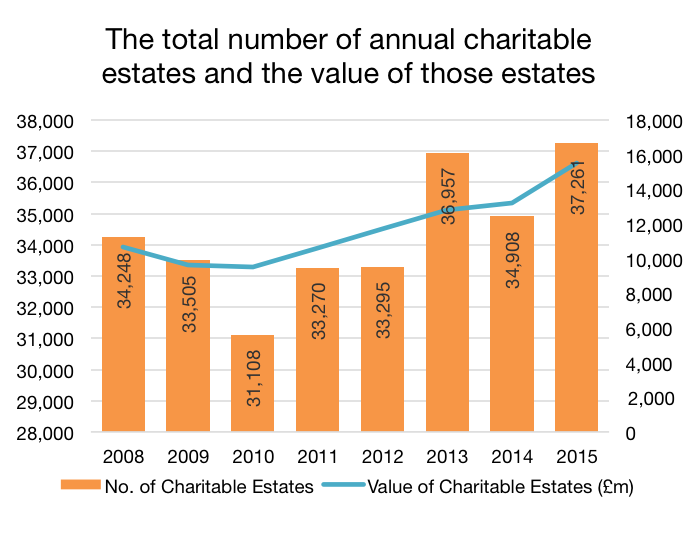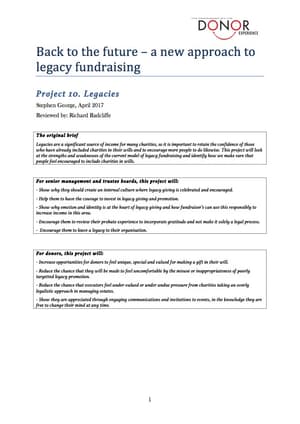CDE project 10 section 2: legacy fundraising today and the opportunity before us
- Written by
- The Commission on the Donor Experience
- Added
- April 29, 2017
Legacy fundraising today
In the past 15 to 20 years, legacy fundraising has embraced new forms of reach and engagement. The rise of digital platforms and other media, namely TV, video and the use of the telephone have increased and developed engagement. In the UK in 2001, a consortium of charities formed a campaign group called Remember a Charity following the Leave a Legacy USA campaign. Remember a Charity established a TV-led approach, with a combination of channels to raise awareness and create a bigger legacy market. In 2007, the campaign shifted its emphasis to changing behaviour. Bigger charities have and are driving TV-led campaigns, and innovation in terms of legacies is beginning to flourish. As an example, take a look at this TV advert for Cancer Research UK.
All over the world, charities are exploring how to reach, inspire and engage new support, but the approach is beginning to embrace the softer, more conversational and influencing approach rather than the overly direct response route. Legacies require a combination of both, but the best way to grow legacy income in the future may be by a more donor-friendly engagement that is informative, inspiring, helpful, uplifting and simple.

The opportunity before us
We are now at a crossroads in terms of legacy fundraising. As we pause and take a look at this moment, we can see that there are five major drivers of change that are pointing us towards this opportunity for legacies.
- The audience is getting older and there will be many more of them in the next 30 years as the death rate increases
- This is the wealthiest generation in human history
- Technology and media are making them accessible and open
- They are increasingly motivated to do good, and to leave a reminder of their time on earth
- We are learning about behaviour in a way that can help meet donors on their terms, encouraging them to take action and leave a gift.
This is an opportunity to inspire and change a generation that has the power to pass on such wealth that it could transform the landscape of the many causes and problems we, and donors, want to solve. It is the one technique in the entire sector that has the potential to raise more than any other.
Stephen Pidgeon, UK Fundraising expert, noted that a well-executed bequest-marketing programme can raise far more money than can a major gifts programme.
Let’s take a look at the current reality of legacy fundraising.
- Legacy income across England and Wales grew 5% from 2013/14 to 2014/15 (from £2.193 billion to £2.293 billion)
- The 2015 (calendar year) saw the highest number of charitable estates on record for England, Scotland and Wales – 37,261. This is an increase of 7% from the previous year
- Scotland has seen a decline in the number of charitable estates (-12% over the past two years) and bequests, while England and Wales have seen an increase. The decline is most prominent in West Scotland. Although the South East of England is responsible for the highest proportion of legacies (almost 12%), it is East and Central England that are seeing the most growth (up by 10% over the past year).
- The value of charitable estates has risen consistently since 2011, with a 17% rise from 2014 to 2015
- While health charities attract most bequests, there is some regional variance. Animals are the next most popular cause in England and Wales, while it is religion in Scotland
- 14.6% of the value of charitable estates (donor wealth) went to charities .
The typical profile of a legator:
- Is female
- Aged 76 when she writes her will
- Dies when she is 83
- Lives in the South of England
- Leaves three charitable bequests in her will
- 35% of charitable wills contain just one charitable bequest, and the most popular cause receiving sole bequests is places of worship
- In 2007, just 12 per cent of those who had died having made a will left a charitable gift. In 2014, this had risen to 17 per cent.
- Source (http://smeeandford.com)

It is important to recognise that income from legacies goes up and down in line with how the economy performs – house prices, inflation and so on. Overall, it is difficult to measure legacies based exclusively on income but, in the long term, it is clear that we are steadily raising more money overall. The key focus is the number of people considering leaving a gift and the number actually doing so. In this case, it is clear that growth is taking place. If this upward curve accelerates, albeit more slowly than we would like, we will have a tremendous opportunity. Moreover, these five drivers will help such an acceleration greatly.
The first driver is the increasing number of people who will live longer. The baby boomer generation has just started turning 70. These figures come from the UK Government website:
- The UK population is projected to increase by 9.7 million over the next 25 years from an estimated 64.6 million in mid-2014 to 74.3 million in mid-2039
- The population is projected to continue ageing, with the average (median) age rising from 40.0 years in 2014 to 40.9 years in mid-2024 and 42.9 years by mid-2039
- By mid-2039, more than 1 in 12 of the population is projected to be aged 80 or over
According to the UK Parliament,
The number of people of ages 65 and over is projected to increase by 23 per cent from 10.3 million in 2010 to 12.7 million in 2018. Growth in this age group is projected to continue for the foreseeable future, with the 65+ population expected to reach 16.9 million by 2035. Source (researchbriefings.files.parliament.uk/documents/SN03228/SN03228.pdf).

The second driver is the wealth of these people. PWC estimated that 36% of the UK’s total liquid wealth—£1.7 trillion—will be in the hands of retirees over the next ten years.
However, the top 10% of Britain’s richest households now own almost half of the country’s £11.1 trillion total private wealth. The Office for National Statistics (ONS) said the average household was worth £225,100 in 2012-14. Thus, whilst wealth has grown, it is concentrated. Overall, this increasing wealth, with a larger volume of people, despite pressures on their finances, presents an opportunity to become part of the wealth transfer that is likely to take place.

The third driver is technology. According to a report in the Huffington Post via the Pew Research Centre,
Internet use among those 65 and older grew 150 percent between 2009 and 2011, the largest growth in a demographic group. Furthermore, their 2012 study showed that of those that go online, 71 percent do so daily and 34 percent use social media. The elderly use these tools to bridge the geographic gap between them and their loved ones far away and as a way to re-connect with friends from a far off time. Studies show that the internet has become an important portal for reducing isolation, loneliness and other depressive symptoms.
According the UK’s Telegraph,
One in four over-65s are now using social networking sites such as Facebook and Twitter, as older people increasingly turn to the internet to share family photographs and keep in touch with loved ones’. The Telegraph dubbed them instagrans, after the photo-sharing website, Instagram. The proportion of over 65s who say they are active on social networks grew by more than 50 per cent last year, according to the Office for National Statistics, rising from 15 per cent to 23 per cent. While nine out of ten under-35s are on social media, younger browser numbers have plateaued; the ONS said that use of the sites was rising fastest amongst the middle-aged and elderly, and had “become part of many adults’ everyday lives”. Source (http://www.telegraph.co.uk/news/2016/08/04/one-in-four-over-65s-use-social-media-after-massive-rise-in-inst/).

The fourth driver is the motivation to do good and to be remembered. According to The Chronicle of Philanthropy in the US, a study by consulting company Age Wave in partnership with Merrill Lynch Global Wealth Management said retirees are expected to donate about $6.6 trillion in cash and $1.4 trillion in volunteer services during the next 20 years as baby boomers retire. The study also found that baby boomers are 49 per cent more likely to make an effort to find out how non-profits use their money before they decide to donate than were their parents’ generation, and 44 per cent of them wanted to direct how their charitable gifts were used, compared with only 15 per cent of their parents’ generation. (https://www.philanthropy.com/article/Baby-Boomers-Poised-to-Give-8/233873)

The final driver is behaviour. In terms of legacies, we are already seeing a shift among those considering leaving a gift in their wills to an increase in those who actually have. In addition, we have seen other shifts in behaviour, particularly amongst baby boomers, who want choice and value, transparency and engagement, and who use on-line resources to research and engage. Combine these behavioural forces with the previous generation that remains a stalwart of giving, and we have the opportunity to engage in new ways that reflect this. However, there is evidence that we have not engaged baby boomers properly. NFP Synergy’s report Facts and Figures - Baby Boomers, Charities, and an Ageing Population, said:
Currently, the generation preceding baby boomers – those born in 1945 or earlier – donate more to charitable causes than any other age group (Campbell: 2013). These ‘mature donors’ give 34% more than boomers, with the latter giving an average of £153.28 a year to 5.4 different causes, and mature donors giving an average of £211.30 to 5.3 different causes (Blackbaud, 2013). There has been a substantial failure to engage the baby boomer generation.
NFP Synergy added,
Charities simply can’t afford to fall out with boomers. As this generation retires, men and women over the age of 50 hold 80% of the UK’s wealth and those over 60 contribute more than half of all charitable donation (Pudelek, 2014). Given the increased pension freedoms and possibility of tax-free lump sums, Future Foundation predicts a potent injection of liquid spending into the UK economy, with around 300,000 people eligible to take advantage of the new provisions this year alone (2015).

These five drivers present a tremendous opportunity. So what does the future hold?
Smee and Ford, a UK-based provider of trusted legacy information for over 100 years, predicted the following:
If we consider that charitable estates were worth £15 billion in 2015, and legacy income was £2.2 billion, we can calculate that 14.6% of the net worth went to charities. Applying this percentage to the total estate values for non-charitable estates (i.e. those that do not contain a gift to charity), legacies could potentially be worth another £7.8 billion to the sector’.

Legacy Foresight, the UK’s foremost analyst of the legacy and in-memory sector, stated in its 2016 Legacy Monitor:
Our latest forecasts suggest that overall legacy market growth rates will average 2.6% p.a. over the next 5 years – this time last year we were predicting 4% p.a. By 2020, UK legacy giving will be worth £2.91bn; or to put it another way, over the next five years UK charities will receive £13.6bn in legacy income. However, once the higher inflation has been taken into account, real growth will be just 1% a year.
The key opportunity is to inspire and engage more people – we need a new level of reach. Economic factors aside, the sheer number and wealth of this new generation and their motivation, behaviour and ability to engage in many new ways presents a combination and challenge to which we must rise.



















